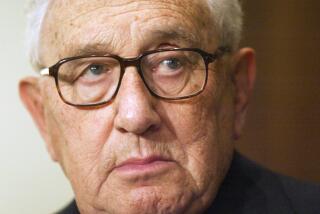Victor Paz Estenssoro; Ex-President of Bolivia Taught at UCLA During Exile
- Share via
LA PAZ, Bolivia — Victor Paz Estenssoro, four-time president of Bolivia and considered one of its most influential politicians, died Thursday after surgery to amputate a leg, doctors said. He was 93.
Doctors operated to repair a blood clot in his right leg, said Guillermo Justiniano, a leader of Paz Estenssoro’s National Revolutionary Movement. He said they amputated the leg at the knee when the clot couldn’t be remedied.
The news shook Bolivians, particularly members of the MNR party, which Paz Estenssoro founded exactly 60 years earlier--June 7, 1941.
Paz Estenssoro was president of Bolivia longer than anyone else, governing from 1952-56, 1960-64, 1964-65 and 1985-89.
His first government nationalized foreign-owned tin mines, redistributed landed estates to thousands of Indian peasants and decreed universal suffrage.
But while becoming Bolivia’s longest-ruling 20th century president, Paz Estenssoro wore out his popularity. Early in his third term in 1964, he was overthrown by the Air Force general who was serving as his vice president.
Over the next three decades he spent 11 years in exile, collaborated with a right-wing military regime and lost three presidential elections.
In 1985, he initiated a neoliberal reform to save the country from inflation that reached record highs of 24,000% a year.
Born in Tarija, the son of a prominent banker, Paz Estenssoro was a lawyer by the age of 20. After service as an artillery sergeant in the 1932-1935 Chaco War with Paraguay, Paz Estenssoro served three terms in Congress and led a group of young veterans in shaping postwar discontent into reformist fervor. They founded the Revolutionary Nationalist Movement, borrowing populist ideals from European Marxism and Fascism.
He served as the country’s finance minister after engineering a 1943 coup to install a reformist military regime. A counter-coup three years later forced him to exile in Juan Peron’s Argentina. He remained there until 1952, when an armed revolt by peasants and tin miners allowed him to return to assume the post of president, to which he had been elected the previous year.
As president, he limited expropriations to large estates and tin mines, attracted U.S. aid and promoted a national class of entrepreneurs.
Exiled again in the mid-1970s, Paz Estenssoro taught history at UCLA and the University of New Mexico.
Elected again in 1985, Paz led a conservative revolution that dealt with the country’s dizzying 24,000% inflation. His government prescribed hard remedies. The currency was devalued by 94%, price supports were lifted, wages were frozen and 17 of the 21 government mines were shut down as highly unprofitable. More than 21,000 miners of the country’s total of 26,500 miners lost their jobs. In all, 35,000 government employees were dismissed.
After leaving office, Paz Estenssoro retired to his birthplace. In the last few years his health has been compromised by a hip fracture as well as an ongoing struggle with Parkinson’s disease.
More to Read
Sign up for Essential California
The most important California stories and recommendations in your inbox every morning.
You may occasionally receive promotional content from the Los Angeles Times.













